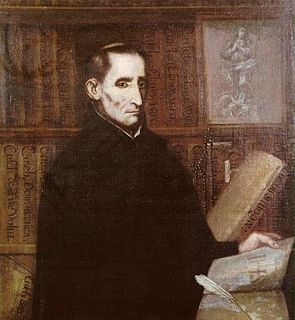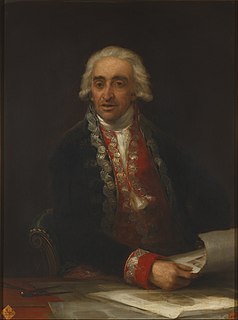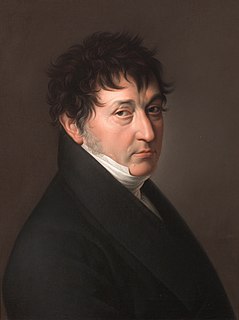
Zarzuela is a Spanish lyric-dramatic genre that alternates between spoken and sung scenes, the latter incorporating operatic and popular songs, as well as dance. The etymology of the name is uncertain, but some propose it may derive from the name of a royal hunting lodge, the Palace of Zarzuela, near Madrid, where that type of entertainment was allegedly first presented to the court. The palace in turn was named after the brambles that grew there.

Aranjuez is a city and municipality of Spain, part of the Community of Madrid.

Juan Eusebio Nieremberg y Ottín was a Spanish Jesuit and mystic.

The Gran Vía street is a street in central Madrid, Spain. It leads from Calle de Alcalá, close to Plaza de Cibeles, to Plaza de España. The street, sometimes referred to as the "Spanish Broadway", is one of the city's most important shopping areas, with a large number of hotels and large movie theatres; however, since the late 2000s, many of these theatres have been replaced by shopping centres.
La Real Sociedad Canina de España is the Spanish kennel club. It was founded in Madrid as the Sociedad Central de Fomento de las Razas Caninas en España on 27 June 1911, and became a legal entity on 12 July 1911; on 1 December 1911 it received the royal patronage of Alfonso XIII, and the word 'Real' was added before the name.

The Metropolis Building or Edificio Metrópolis (Spanish) is an office building in Madrid, Spain, at the corner of the Calle de Alcalá and Gran Vía. Inaugurated in 1911, it was designed by Jules and Raymond Février for the insurance company La Unión y el Fénix. It is currently owned by Metrópolis Seguros.

Juan de Villanueva was a Spanish architect. Alongside Ventura Rodríguez, Villanueva is the best known architect of Spanish Neoclassicism.
Madrid, the capital of Spain, is divided into 21 districts, which are further subdivided into 131 administrative wards. Additional neighborhoods exist outside the boundaries of administrative borders. Each district is governed by a body named Junta Municipal de Distrito. Residents of Madrid are typically called Madrileños.

Plaça de Lesseps is a square serving as the border between the Sarrià-Sant Gervasi and Gràcia district of Barcelona, Catalonia, Spain, loosely divided in two parts. One of the most heavily transited squares in the city, Lesseps is the starting point of one of Barcelona's busiest rondes: Ronda del General Mitre, as well as being the west end of Carrer Gran de Gràcia and being crossed by a number of streets, namely: Travessera de Dalt, Avinguda del Príncep d'Astúries, Avinguda de Vallcarca, Avinguda de la República Argentina, Carrer del Torrent de l'Olla, Carrer de la Mare de Déu del Coll, Carrer de Santa Perpètua, Carrer de Maignon and Carrer de Pérez Galdós.

Sierra Suroeste is a comarca located in southwestern province of Badajoz in the autonomous community of Extremadura, western Spain. Its capital and largest city is Jerez de los Caballeros.
Plaça de Gal·la Placídia is a square split between the districts of Gràcia and Sarrià-Sant Gervasi, in Barcelona, Catalonia, Spain. Its exact location is between Travessera de Gràcia, Carrer de Neptú, Carrer de Milton, Carrer de l'Oreneta and Via Augusta.

The Edificio Grassy is a building located at 1 Gran Vía in Madrid, Spain.

Our Lady of the Forsaken is a Catholic invocation of the Virgin Mary. She is the patroness of Valencia and one of seven patrons of the Autonomous communities of Spain. She appears with a lily in one hand and in the other, she carries the baby Jesus who bears the cross in his arms. Her posture is characterized by a slight forward tilt, and hence, she is known affectionately as the Geperudeta (hunchback) of Valencia. Her image is housed in the 'Basilica de la Virgen de los Desamparados'.

The Oratorio di San Protaso is a church in via Lorenteggio, Milan, Lombardy.

Zacarías González Velázquez was a Spanish painter; known primarily for his portraits and religious works.

Anastasio de Gracia Villarrubia was a Spanish bricklayer, trade union leader and socialist politician. He became a national delegate during the Second Spanish Republic (1931–1939). During the Spanish Civil War (1936–1939) he was a minister in the government of Francisco Largo Caballero from September 1936 to May 1937. After the defeat of the Republicans he went into exile in Mexico, where he lived for more than forty years.

The Oratory of Saint Philip Neri is a former church in Toledo. The building was used by the Congregation of the Oratory of Saint Philip Neri as an oratory (chapel).

The Centro Cultural de los Ejércitos, is an educational military society currently based at Gran Vía 13 in Madrid. The building is also commonly known as Casino Militar.
















